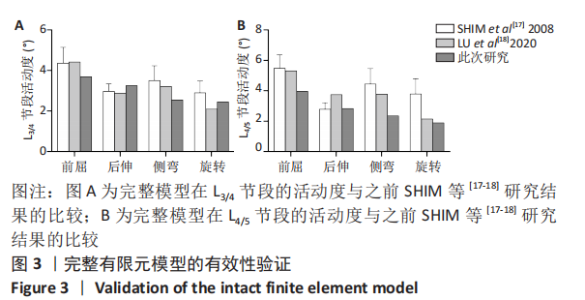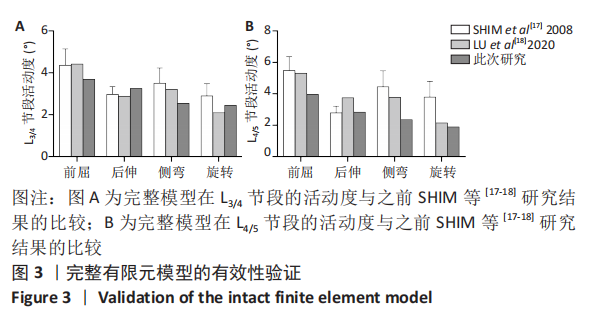Chinese Journal of Tissue Engineering Research ›› 2023, Vol. 27 ›› Issue (22): 3445-3450.doi: 10.12307/2023.398
Finite element analysis of polyetheretherketone and titanium rods in posterior lumbar interbody fusion
Li Jie1, Cao Shuai2, Guo Dong1, Zhang Qiongchi1, He Xijing1, Li Haopeng1, Lu Teng1
- 1Second Department of Orthopedics, The Second Affiliated Hospital of Xi’an Jiaotong University, Xi’an 710004, Shaanxi Province, China; 2Department of Orthopedics, Civil Aviation General Hospital, Beijing 100123, China
-
Received:2022-06-09Accepted:2022-07-21Online:2023-08-08Published:2022-11-01 -
Contact:Lu Teng, Physician, MD, Second Department of Orthopedics, The Second Affiliated Hospital of Xi’an Jiaotong University, Xi’an 710004, Shaanxi Province, China Li Haopeng, Professor, Chief physician, Doctoral supervisor, Second Department of Orthopedics, The Second Affiliated Hospital of Xi’an Jiaotong University, Xi’an 710004, Shaanxi Province, China -
About author:Li Jie, Master candidate, Second Department of Orthopedics, The Second Affiliated Hospital of Xi’an Jiaotong University, Xi’an 710004, Shaanxi Province, China -
Supported by:Natural Science Basic Research Program of Shaanxi, No. 2022-JQ195 (to LT); National Natural Science Foundation of China, No. 82172396 (to LHP)
CLC Number:
Cite this article
Li Jie, Cao Shuai, Guo Dong, Zhang Qiongchi, He Xijing, Li Haopeng, Lu Teng. Finite element analysis of polyetheretherketone and titanium rods in posterior lumbar interbody fusion[J]. Chinese Journal of Tissue Engineering Research, 2023, 27(22): 3445-3450.
share this article
Add to citation manager EndNote|Reference Manager|ProCite|BibTeX|RefWorks
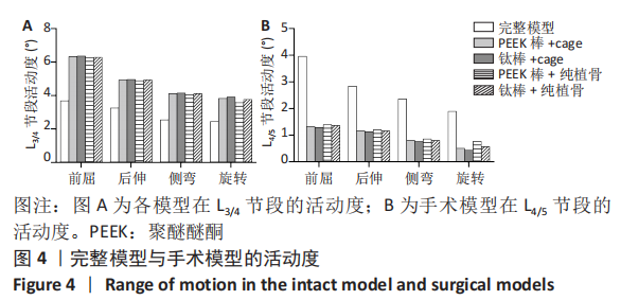
2.2 节段活动度 总体上,与完整模型相比,所有手术模型中固定节段的活动度明显降低,而邻近节段的活动度明显增加,但是4个手术模型之间的活动度无明显差异。具体而言,在完整模型、聚醚醚酮棒+cage、钛棒+cage、聚醚醚酮棒+纯植骨和钛棒+纯植骨模型中,L3/4节段活动度在前屈工况下分别为3.69°,6.33°,6.36°,6.26°,6.29°;在后伸工况下分别为3.26°,4.93°,4.96°,4.89°,4.93°;在侧弯工况下分别为2.55°,4.11°,4.15°,4.05°,4.11°;在轴向旋转工况下分别为2.45°,3.83°,3.91°,3.58°,3.77°(图4A)。在上述模型中,L4/5节段活动度在前屈工况下分别为3.96°,1.32°,1.29°,1.40°,1.36°;在后伸工况下分别为2.84°,1.16°,1.13°,1.20°,1.16°;在侧弯工况下分别为2.36°,0.80°,0.76°,0.86°,0.80°;在轴向旋转工况下分别为1.90°,0.51°,0.44°,0.77°,0.57°(图4B)。"
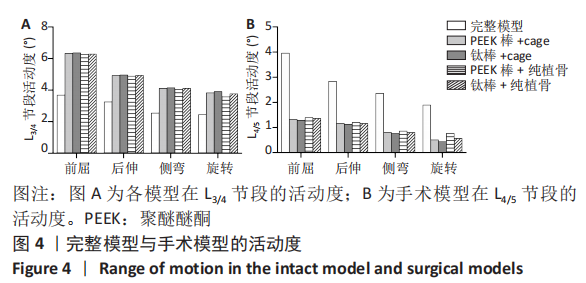
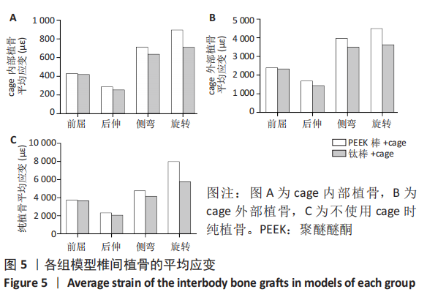
2.3 椎间植骨应变 在聚醚醚酮棒+cage与钛棒+cage模型中,各个工况下cage内部植骨的平均应变分别为288.33-896.55 με和255.66-711.44 με(图5A);cage外部植骨的平均应变分别为1 689.37-4 499.69 με和1 445.58-3 625.74 με(图5B)。在聚醚醚酮棒+纯植骨和钛棒+纯植骨模型中,椎间植骨的平均应变分别为2 327.58-7 992.91 με和2 072.77-5 754.19 με(图5C)。总体而言,4个手术模型中,聚醚醚酮棒+纯植骨模型的平均植骨应变最大,依次是钛棒+纯植骨、聚醚醚酮棒+cage、钛棒+cage。"
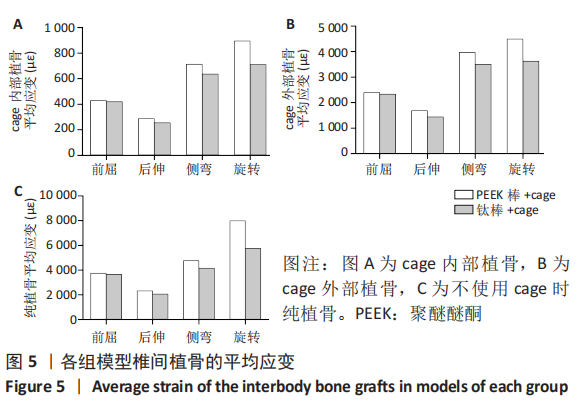
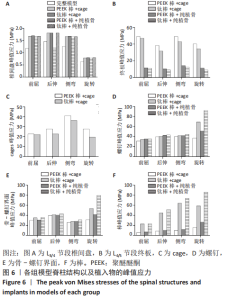
2.4 椎间盘、终板与cage应力 相比于完整模型,所有手术模型L3/4节段椎间盘峰值应力均增加(完整模型为0.64-1.46 MPa,手术模型为0.78-1.81 MPa)。在聚醚醚酮棒+cage、钛棒+cage、聚醚醚酮棒+纯植骨、钛棒+纯植骨模型中,L3/4节段椎间盘的峰值应力差别不大,分别为0.79-1.81 MPa、0.80-1.81 MPa、0.78-1.66 MPa、0.80-1.81 MPa(图6A);然而,L4/5终板的峰值应力分别为38.26-48.99 MPa、31.66-46.97 MPa、10.37-14.19 MPa和8.96-12.31 MPa(图6B),可以看出使用cage与否对终板的影响大于棒的材料。在聚醚醚酮棒+cage和钛棒+cage模型中,cage的峰值应力分别为22.78-41.20 MPa和22.19-36.22 MPa(图6C)。 2.5 钉棒系统应力 在聚醚醚酮棒+cage、钛棒+cage、聚醚醚酮棒+纯植骨、钛棒+纯植骨模型中,螺钉的峰值应力分别为31.49-39.81 MPa、34.27-69.22 MPa、35.60-51.03 MPa和35.73-92.32 MPa(图6D);骨-螺钉界面的峰值应力分别为25.97-39.85 MPa、27.78-53.77 MPa、28.00-41.58 MPa和31.09-79.84 MPa(图6E);棒的峰值应力分别为6.01-15.69 MPa、23.06-64.26 MPa、7.14-26.37 MPa和23.36-86.33 MPa,因此棒的峰值应力主要取决于棒自身材料,即聚醚醚酮棒的峰值应力明显小于钛棒(图6F)。考虑棒自身的峰值应力与屈服应力(钛,750 MPa;聚醚醚酮,100 MPa)之比,聚醚醚酮棒的该比值为6%-26%,高于钛棒的3%-12%。"
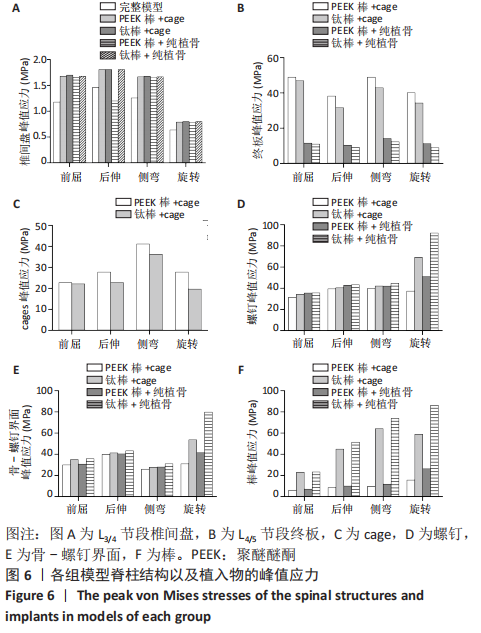
| [1] REID PC, MORR S, KAISER MG. State of the union: a review of lumbar fusion indications and techniques for degenerative spine disease. J Neurosurg Spine. 2019;31(1):1-14. [2] OGRENCI A, KOBAN O, YAMAN O, et al. Polyetheretherketone Rods in Lumbar Spine Degenerative Disease: Mid-term Results in a Patient Series Involving Radiological and Clinical Assessment. Turk Neurosurg. 2019;29(3): 392-399. [3] MAVROGENIS AF, VOTTIS C, TRIANTAFYLLOPOULOS G, et al. PEEK rod systems for the spine. Eur J Orthop Surg Traumatol. 2014;24 Suppl 1:S111-116. [4] DE IURE F, BOSCO G, CAPPUCCIO M, et al. Posterior lumbar fusion by peek rods in degenerative spine: preliminary report on 30 cases. Eur Spine J. 2012;21 Suppl 1:S50-54. [5] HIRT D, PRENTICE HA, HARRIS JE, et al. Do PEEK Rods for Posterior Instrumented Fusion in the Lumbar Spine Reduce the Risk of Adjacent Segment Disease? Int J Spine Surg. 2021;15(2):251-258. [6] LI C, LIU L, SHI JY, et al. Clinical and biomechanical researches of polyetheretherketone (PEEK) rods for semi-rigid lumbar fusion: a systematic review. Neurosurg Rev. 2018;41(2):375-389. [7] PONNAPPAN RK, SERHAN H, ZARDA B, et al. Biomechanical evaluation and comparison of polyetheretherketone rod system to traditional titanium rod fixation. Spine J. 2009;9(3):263-267. [8] ROSS DA, ROSS MN. Lumbar Fusion With Polyetheretherketone Rods Use for Patients With Degenerative Disease. Fed Pract. 2021;38(Suppl 1):S9-S16. [9] WU J, SHI L, LIU D, et al. Evaluating Screw Stability After Pedicle Screw Fixation With PEEK Rods. Global Spine J. 2021:2192568221996692. [10] GORNET MF, CHAN FW, COLEMAN JC, et al. Biomechanical assessment of a PEEK rod system for semi-rigid fixation of lumbar fusion constructs. J Biomech Eng. 2011;133(8):081009. [11] RANA M, BISWAS JK, ROY S, et al. Motion analysis of lumbar vertebrae for different rod materials and flexible rod device – An experimental and finite element study. Biocybernetics and Biomedical Engineering. 2020;40(1): 415-425. [12] HSIEH YY, TSUANG FY, KUO YJ, et al. Biomechanical analysis of single-level interbody fusion with different internal fixation rod materials: a finite element analysis. BMC Musculoskelet Disord. 2020;21(1):100. [13] MESBAH M, BARKAOUI A. Is Pedicle-Based Hybrid Stabilization (PBHS) protecting posterior lumbar fixation from adjacent-segment failure? Finite element analysis and comparison of different systems. Orthop Traumatol Surg Res. 2021;107(7):103038. [14] WANG H, WAN Y, LIU X, et al. The biomechanical effects of Ti versus PEEK used in the PLIF surgery on lumbar spine: a finite element analysis. Comput Methods Biomech Biomed Engin. 2021;24(10):1115-1124. [15] XIAO Z, WANG L, GONG H, et al. Biomechanical evaluation of three surgical scenarios of posterior lumbar interbody fusion by finite element analysis. Biomed Eng Online. 2012;11:31. [16] LIU Z, LIU J, TAN Y, et al. A comparative study between local bone graft with a cage and with no cage in single posterior lumbar interbody fusion (PLIF): a multicenter study. Arch Orthop Trauma Surg. 2014;134(8):1051-1057. [17] SHIM CS, PARK SW, LEE SH, et al. Biomechanical evaluation of an interspinous stabilizing device, Locker. Spine (Phila Pa 1976). 2008;33(22):E820-E827. [18] LU T, LU Y. Interlaminar stabilization offers greater biomechanical advantage compared to interspinous stabilization after lumbar decompression: a finite element analysis. J Orthop Surg Res. 2020;15(1):291. [19] SELIM A, MERCER S, TANG F. Polyetheretherketone (PEEK) Rods for Lumbar Fusion: A Systematic Review and Meta-Analysis. Int J Spine Surg. 2018; 12(2):190-200. [20] HUANG W, ChANG Z, SONG R, et al. Non-fusion procedure using PEEK rod systems for lumbar degenerative diseases: clinical experience with a 2-year follow-up. BMC Musculoskelet Disord. 2016;17:53. [21] YEAGER MS, COOK DJ, CHENG BC. In Vitro Comparison of Dynesys, PEEK, and Titanium Constructs in the Lumbar Spine. Adv Orthop. 2015;2015:895931. [22] PONNAPPAN RK, SERHAN H, ZARDA B, et al. Biomechanical evaluation and comparison of polyetheretherketone rod system to traditional titanium rod fixation. Spine J. 2009;9(3):263-267. [23] AHN YH, CHEN WM, LEE KY, et al. Comparison of the load-sharing characteristics between pedicle-based dynamic and rigid rod devices. Biomedical Materials. 2008;3(4):044101. [24] CUNNINGHAM BW, POLLY DW. The use of interbody cage devices for spinal deformity: a biomechanical perspective. Clin Orthop Relat Res. 2002;(394): 73-83. [25] 漆龙涛, 李淳德, 张正. 腰椎融合术后假关节形成的诊断和手术治疗[J]. 中国骨与关节杂志,2017,6(11):847-851. [26] 张舒, 吴兴裕, 李莹辉. 骨骼的功能适应性与应力应变反应[J]. 航天医学与医学工程,2001,14(5):368-372. [27] CHEN JH, LIU C, YOU L, et al. Boning up on Wolff’s Law: mechanical regulation of the cells that make and maintain bone. J Biomech. 2010;43(1): 108-118. [28] 宋振杰, 刘洪江, 唐汉武, 等. 腰椎融合术中应用聚醚醚酮棒与钛棒疗效对比的Meta分析[J]. 实用医学杂志,2021,37(12):1580-1586. [29] DONG E, SHI L, KANG J, et al. Biomechanical characterization of vertebral body replacement in situ: Effects of different fixation strategies. Comput Methods Programs Biomed. 2020;197:105741. [30] 杨红军, 樊勇, 吴子祥, 等. 新型PEEK棒半刚性固定系统应用于腰椎退变性疾病手术治疗的临床疗效[J]. 中国脊柱脊髓杂志,2015,25(9): 826-831. [31] 钱嘉铭, 李春根, 尹辛成, 等. 聚醚醚酮棒与钛棒椎弓根钉固定腰椎退行性病的比较[J]. 中国矫形外科杂志,2022,30(9):1-5. [32] 黄伟敏, 许小多, 韩志伟, 等. 聚醚醚酮棒椎弓根螺钉系统在多节段腰椎退行性疾病治疗中的应用[J]. 生物骨科材料与临床研究,2018,15(4): 29-33. [33] FAN W, GUO LX, ZHANG M. Biomechanical analysis of lumbar interbody fusion supplemented with various posterior stabilization systems. Eur Spine J. 2021;30(8):2342-50. [34] JIN YJ, KIM YE, SEO JH, et al. Effects of rod stiffness and fusion mass on the adjacent segments after floating mono-segmental fusion: a study using finite element analysis. Eur Spine J. 2013;22(5):1066-1077. [35] GALBUSERA F, BELLINI CM, ANASETTI F, et al. Rigid and flexible spinal stabilization devices: a biomechanical comparison. Med Eng Phys. 2011; 33(4):490-496. [36] 王华强, 滕勇, JIANCHANG C. 自体骨移植在腰椎后路椎间融合中的临床疗效分析[J]. 临床外科杂志,2016,24(5):349-352. |
| [1] | Peng Zhixin, Yan Wengang, Wang Kun, Zhang Zhenjiang. Finite element analysis and structural optimization design of 3D printed forearm braces [J]. Chinese Journal of Tissue Engineering Research, 2023, 27(9): 1340-1345. |
| [2] | Wu Tianliang, Tao Xiuxia, Xu Hongguang. Influence of different bone mineral densities on cage subsidence after stand-alone oblique lateral interbody fusion: three-dimensional finite element analysis [J]. Chinese Journal of Tissue Engineering Research, 2023, 27(9): 1352-1358. |
| [3] | Liu Jinyu, Zhang Hanshuo, Cui Hongpeng, Pan Lingzhi, Zhao Boran, Li Fei, Ding Yu. Finite element biomechanical analysis of minimally invasive treatment of cervical spondylotic myelopathy and accurate exercise rehabilitation [J]. Chinese Journal of Tissue Engineering Research, 2023, 27(9): 1359-1364. |
| [4] | He Yujie, Kang Zhijie, Xue Mingming, Jin Feng, Li Zhijun, Wang Xing, Xu Yangyang, Gao Mingjie, Li Jiawei, Li Xiaohe, Wang Haiyan. Finite element analysis of transarticular screw fixation of adolescent thoracic vertebra [J]. Chinese Journal of Tissue Engineering Research, 2023, 27(9): 1365-1370. |
| [5] | Wen Xinghua, Ding Huanwen, Cheng Kai, Yan Xiaonan, Peng Yuanhao, Wang Yuning, Liu Kang, Zhang Huiwu. Three-dimensional finite element model analysis of intramedullary nailing fixation design for large femoral defects in Beagle dogs [J]. Chinese Journal of Tissue Engineering Research, 2023, 27(9): 1371-1376. |
| [6] | Zhu Lin, Gu Weiping, Wang Can, Chen Gang. Biomechanical analysis of All-on-Four and pterygomaxillary implants under different maxillary bone conditions [J]. Chinese Journal of Tissue Engineering Research, 2023, 27(7): 985-991. |
| [7] | Sun Jiangwei, Wang Junxiang, Baibujiafu·Yellisi, Dai Huijuan, Nijati·Turson. Three-dimensional finite element analysis of stress distribution in different smooth collar implants [J]. Chinese Journal of Tissue Engineering Research, 2023, 27(7): 1004-1011. |
| [8] | Jiang Yifang, Cai Qimin, Chu Zhengyi, Qin Min, Shen Yurong, Gu Yuanping. Simulation analysis of stress distribution of NRT FILES in curved root canals [J]. Chinese Journal of Tissue Engineering Research, 2023, 27(7): 1038-1042. |
| [9] | Li Huiqin, Wang Chunjuan, Wang Yu, Wang Weifeng, Chen Dinggen, Li Na. Clear aligner orthodontic therapy of rotated mandibular teeth with different shapes: a three-dimensional finite element analysis [J]. Chinese Journal of Tissue Engineering Research, 2023, 27(7): 1050-1054. |
| [10] | Liu Qinghua, Cai Yongqiang, Jin Feng, Yu Jinghong, Wang Haiyan, Zhang Yunfeng, Wang Lidong, Li Jiawei, Wang Xing, He Yujie, Dai Lina, Wang Jianzhong, Wu Chao, Tong Ling, Kang Zhijie, Li Zhijun, Li Xiaohe. Finite element model of the 12-year-old child whole cervical spine: establishment and validity verification based on CT data [J]. Chinese Journal of Tissue Engineering Research, 2023, 27(4): 500-504. |
| [11] | Lu Hui, Wu Qimei, Liu Rong. Finite element analysis and application of unilateral and bilateral bone-filling mesh container in treatment of osteoporotic vertebral compression fracture [J]. Chinese Journal of Tissue Engineering Research, 2023, 27(3): 391-397. |
| [12] | Gao Hongliang, Li Xusheng, Wang Zhenhu, Zhang Xiaomin, Li Peng, Zhang Tao, Liu Hua, Li Songkai. Three-dimensional finite element analysis of the treatment of lumbar spondylolysis with cannulated lag screw [J]. Chinese Journal of Tissue Engineering Research, 2023, 27(22): 3451-3456. |
| [13] | Chen Jianquan, Chen Maoshui, Lyu Zhouming, Chen Rongbin, Yu Zhaoyu, Liu Wanpeng, Lin Xinyuan, Lin Dingkun. Biomechanical properties of cortical bone trajectory combined with pedicle screw fixation on vertebral body motion unit: a finite element analysis [J]. Chinese Journal of Tissue Engineering Research, 2023, 27(22): 3457-3462. |
| [14] | Xu Biao, Lu Tan, Yang Junliang, Jiang Yaqiong, Yin Yujiao. Three-dimensional finite element analysis of the stress of the patellofemoral joint after medial patellofemoral ligament reconstruction by different femoral reconstruction insertion points [J]. Chinese Journal of Tissue Engineering Research, 2023, 27(22): 3463-3468. |
| [15] | Xia Yubo, Tang Xiaoxia, Luo Wen, Xu Yongsheng, Yuan Changfei, Wang Zhe, Zhou Xiaohan, Tian Miao, Wang Tao, Guo Ying. Biomechanical response of ankle traction arthroplasty for ankle osteoarthritis through finite element modeling [J]. Chinese Journal of Tissue Engineering Research, 2023, 27(22): 3469-3475. |
| Viewed | ||||||
|
Full text |
|
|||||
|
Abstract |
|
|||||
